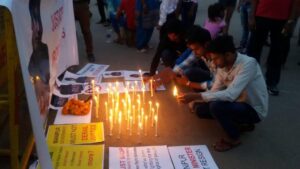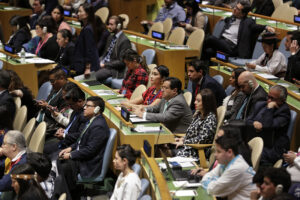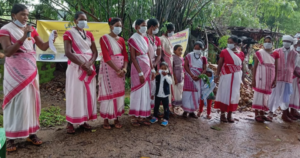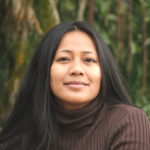Minds of the Movement
An ICNC blog on the people and power of civil resistance
by Binalakshmi "Bina" NepramFebruary 23, 2022
In my first post, I described the emergence of the global Indigenous women’s movement, dating back to 1995 with groundwork happening as early as the 1970s. In this post, I delve into the deeper questions of strategic planning, sustaining momentum, and how the global movement’s victories have impacted Indigenous grassroots organizing worldwide.
Leadership and strategy

Vigil against martial law in Manipur, 2017. Indigenous women-led struggles forge ahead at the local level as their representatives unite with other struggles for international lobbying. Credit: Control Arms Foundation of India Facebook.
At the turn of the century, a great deal of momentum had already been generated for Indigenous women’s rights at the international level. A number of high-level processes were key at helping sustain this momentum but also serve as space to regroup on strategy and formalize the actors’ organizing work. Training, information sessions, workshops and strategy sessions were the main objectives of the historic International Indigenous Women’s Forum on Beijing+5, held on June 1 and 2, 2000, in New York City. Over 60 Indigenous women participated in the Forum from around the world.
Acting as central movement leadership, the International Indigenous Women’s Steering Committee that had formed the previous year developed terms of reference and a mission statement to guide their work—a sort of movement vision. The committee also agreed to keep one hand in the realm of extra-institutional actions, for example joining forces with the 2000 World March of Women. At the same time, they took care to expand their alliances, reaching out to organizers of the 2001 World Conference Against Racism, Racial Discrimination, Xenophobia and Related Intolerance. Finally, as New York houses the UN Permanent Forum on Indigenous Issues and the UN Commission on Status of Women, in later years Indigenous women utilized these existing spaces to come together to work for collective change.
But coming back to June 2000, at the UN General Assembly, a declaration was adopted reaffirming the Beijing Declaration of Indigenous Women, the right to self-determination of Indigenous Peoples, connection to land and territory, and the balance that is required to ensure the well-being of Indigenous peoples. As I explore below, these breakthroughs have had significant impact at the grassroots level worldwide.
Movement victories, future direction

The 2017 UN Permanent Forum on Indigenous Issues, celebrating the 10-year anniversary of the UN Declaration on the Rights of Indigenous Peoples. Credit: UN Women (CC BY-NC-ND 2.0), unedited).
What have Indigenous women gained through their strategic pivot into international decision-making processes? We must be reminded that Indigenous women had previously been left out of decision-making at the UN and other global platforms. This is why they started organizing themselves to change this in the first place.
Due to the work at the 2000 UN General Assembly, Indigenous women were able to raise the profile of their cause. Networking also began and relationships among Indigenous women throughout the world were solidified.
Several additional breakthroughs came in more recent years, such as the mention of the word “Indigenous women” in several UN documents and a resolution following their strong work and advocacy. For example, the UN Commission on the Status of Women and the UN Permanent Forum of Indigenous Issues, and numerous UN resolutions specifically mentioned Indigenous women now. This provided local Indigenous struggles with international norms on which to base their messaging. It validated the work of local Indigenous movements and communicates to them that they are not alone in their struggle for rights.
One of many examples of local campaigns that have gained visibility is the Manipur Women Gun Survivors Network that was launched in Manipur in 2007, entirely by Indigenous women. The campaign, 20,000+ participants strong, received a series of international awards for their work against living under a constant shadow of a martial law called Armed Forces Special Powers Act.
Year after year, Indigenous women led by FIMI (Foro Internacional de Mujeres Indígenas) and many others have been a part of several meetings at the UN and several multilateral platforms leveraging pressure for better recognition for Indigenous rights. In 2019, the Global Alliance of Indigenous Peoples, Gender Justice and Peace—an enduring structure—was formed in New York City to carry the important work that started in 1995.
An Indigenous-led movement operating on Indigenous principles

The global movement of Indigenous women have been organizing to respond to the Covid-19 crisis. Credit: International Indigenous Women’s Forum (IIWF).
The emergence of a global Indigenous women’s movement was made possible by the presence of strong women organizing on the ground in numerous countries worldwide. Their movements were direly seeking representation for their cause. As most of the international organizing has been conducted according to “Indigenous principles” of respect, equal representation, consultation, and not exploitation or project-oriented, the global Indigenous women’s movement continues to grow from strength to strength till today.
The global Indigenous women’s movement has not lost momentum. The formation in 2019 of the Global Alliance of Indigenous Peoples, Gender Justice and Peace, gathering Indigenous women from seven socio-cultural indigenous zones of the world, is the latest form of organizing that has emerged. It shows the continuing strengthening of the movement that started over 30 years ago and that will no doubt continue its important work in the years to come.
As the global movement continues from small victory to small victory, it is important to remember the first words that were written in the historic Indigenous women’s declaration in Beijing 1995:
We, the women of the original peoples of the world have struggled actively to defend our rights to self-determination and to our territories which have been invaded and colonized by powerful nations and interests. We have been and are continuing to suffer from multiple oppressions; as Indigenous peoples, as citizens of colonized and neo-colonial countries, as women, and as members of the poorer classes of society. In spite of this, we have been and continue to protect, transmit, and develop our Indigenous cosmovision, our science and technologies, our arts and culture, and our Indigenous socio-political economic systems, which are in harmony with the natural laws of mother earth. We still retain the ethical and aesthetic values, the knowledge and philosophy, the spirituality, which conserves and nurtures Mother Earth. We are persisting in our struggles for self-determination and for our rights to our territories. This has been shown in our tenacity and capacity to withstand and survive the colonization happening in our lands in the last 500 years.

Binalakshmi “Bina” Nepram
Binalakshmi “Bina” Nepram is an award-winning scholar and civil rights activist who is Founder-Director of Manipur Women Gun Survivors Network/CAFI. Bina was born in Manipur Nation currently located in India’s northeast region next to Myanmar. She is the founder of two other organizations working on peace and justice and has authored five books.
Read More